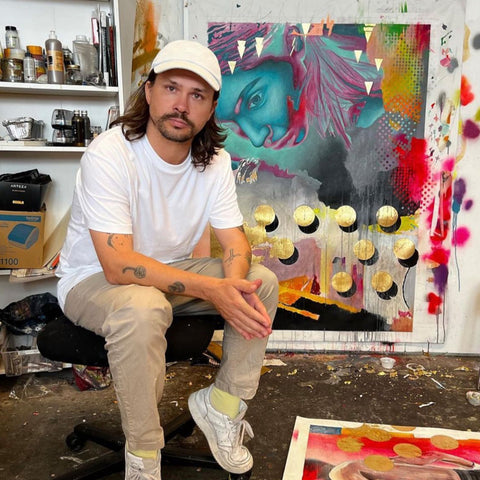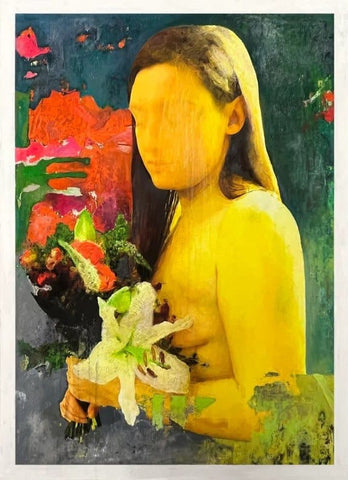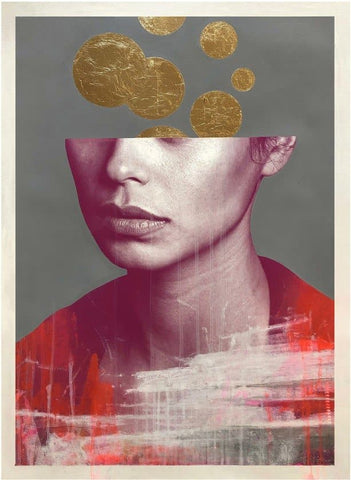This week, we’re delighted to announce that the work of British artist, Ben Slow is now available at Enter Gallery.
Best known for street art murals depicting residents of the areas he’s painting in, Ben Slow’s photorealistic portraits have gone through an evolution, moving from the street to the studio, where he creates abstract works that draw from his own life.
In today’s blog, we’re chatting to Slow to discover more about how his art has evolved since his street art days, and to learn about the steps involved in creating his colourful stylised portraits.
School’s Out
More often than not, artists begin their careers creating street art, later transitioning into the gallery space when their work starts to gain a following. Ben Slow is an artist who subverts this trend. With a fine art education, Slow turned his hand to street art after becoming disillusioned with the art world. He explains:
“My art college experience was weird – one tutor even told me, ‘painting was over’, which was why Banksy and people like that were so interesting to me when I discovered them. As I was falling out of love with one thing (fine art), I was falling in love with something that was sticking two fingers up at that.”
Street Spirit
Slow jumped into the street art world with gusto, producing stickers, then paste ups, and soon large-scale murals. Over the space of the next half a decade, his art took him around the world, creating murals highlighting issues such as racism and homelessness, inspired by the people he met, and the stories he heard.

Slow’s street art portraits focused on ‘great characters’, and using his artistic talents to pay homage to those who deserve to be celebrated. Speaking of this period, Slow explains:
“While doing street art, I quickly realised that I wanted to create art that fit in with its environment. I’d go out and research a location and try and tell a story that was linked to the location rather than just splurge my ego on the wall before leaving. I loved the painting but the painting was a small part of the process – it was also the travel, the people, what I learned about an area, the new friends.”

Mining from Life
With both the world and the face of street art changing over the last few years, Slow has once again found himself in a place of creative development and discovery, taking him from portraits of others to works that are more autobiographical in nature. Revealing what sparked this change, Slow tells us:
“Since Covid, my studio practice has been my main focus. I love art, I live and breathe it, and I’ve found my groove, where I want to be and where I want to go. Now, the direction I’m taking my work in is more autobiographical, based on my life, and my day-to-day. What I’m going through, what the people around me are going through. It’s much more fulfilling and true to me.”
Slow’s work, Adrift at Sea is an example of this autobiographical slant, offering a glimpse into his personal life, and into a bad year with an ex-girlfriend who was seriously ill. While infused with meaning, Slow also likes to leave his art ambiguous enough so it remains open to interpretation. He explains:
“There’s always a story to my work, but I’m a firm believer that what other people tell me they see is a lot more interesting than what I see. Kids are the best for that, especially when you’re painting on the street. I like giving people a suggestion, but on the other hand, I want it to be organic. I want to put that interpretation into other people’s hands.”

Layer Upon Layer
We’re always fascinated to discover how our artists create their works, and Slow has a particularly interesting process. Each piece begins life with a draft created in a digital format - a medium he’s drawn to as it allows him to take risks and play around until he hits on something that feels right.

Slow then prints out his work and brings it to life with all manner of materials, from oil and acrylic paints, to ink and spray paint. He reveals:
“I spend a lot of time working on each piece digitally – taking images, overlaying other images, abstracting, filters. Via a lot of trial and error and a lot of mistakes, I build up a digital draft. For me though, digital can only take it so far. Analogue allows for much more. The mark making, the mistakes, the changes, they take on a whole life of their own once I start painting them.
Every piece I create needs to have emotion and texture. So I print out the digital version and start painting on top, heavily working on it with everything – oil, spray, acrylics – to bring that piece to life. Once I create an edition, I hand-finish them again with paint, oil, pencil, gold leaf - a bit of everything really.”
This meeting of digital and analogue realms has also influenced the style of his art, and the detail within. He explains:
“When you’re experimenting and tearing things apart, you end up with different effects that can be very digital looking. That contrast between the effects that are created digitally and those that are created by hand are what I am combining. I want those differences to come together in my work because it’s representative of the world we live in.”
Change is Good
Speaking of his movement between aesthetics, Slow explains that as he has learnt more about himself and what matters to him, a change in his artistic style was more or less inevitable… and he doesn’t rule it out happening again.
“I don’t think that restless mind element of my work is ever going to change. It’s natural to get bored with what you’re doing and want to do something different. It’s about being okay with where you came from so you can figure out where you want to take it next. My focus is on staying in tune with my practice so I can keep things exciting.”
Ben Slow’s work is available at Enter Gallery now. Explore the collection here.







